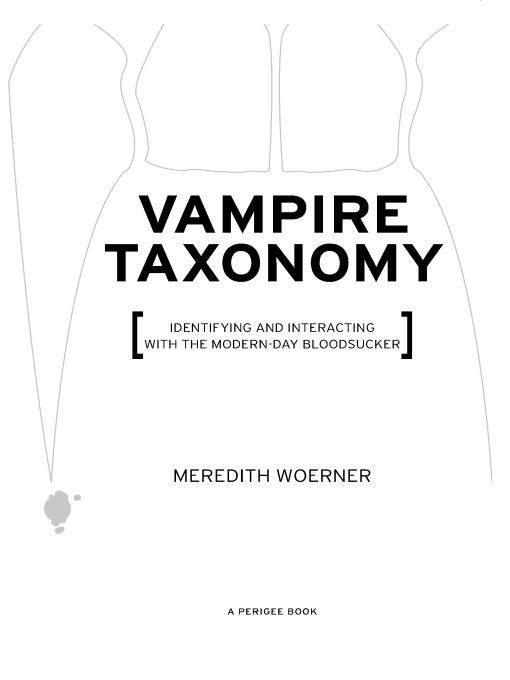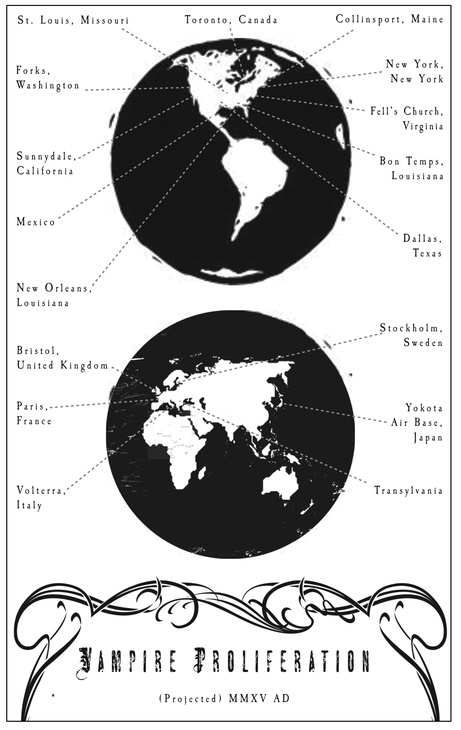Vampire Taxonomy
Authors: Meredith Woerner


Table of Contents

A PERIGEE BOOK
Published by the Penguin Group
Penguin Group (USA) Inc.
375 Hudson Street, New York, New York 10014, USA
Penguin Group (Canada), 90 Eglinton Avenue East, Suite 700, Toronto, Ontario M4P 2Y3, Canada
(a division of Pearson Penguin Canada Inc.)
Penguin Books Ltd., 80 Strand, London WC2R 0RL, England
Penguin Group Ireland, 25 St. Stephen’s Green, Dublin 2, Ireland (a division of Penguin Books Ltd.)
Penguin Group (Australia), 250 Camberwell Road, Camberwell, Victoria 3124, Australia
(a division of Pearson Australia Group Pty. Ltd.)
Penguin Books India Pvt. Ltd., 11 Community Centre, Panchsheel Park, New Delhi—110 017, India
Penguin Group (NZ), 67 Apollo Drive, Rosedale, North Shore 0632, New Zealand
(a division of Pearson New Zealand Ltd.)
Penguin Books (South Africa) (Pty.) Ltd., 24 Sturdee Avenue, Rosebank, Johannesburg 2196,
South Africa
Published by the Penguin Group
Penguin Group (USA) Inc.
375 Hudson Street, New York, New York 10014, USA
Penguin Group (Canada), 90 Eglinton Avenue East, Suite 700, Toronto, Ontario M4P 2Y3, Canada
(a division of Pearson Penguin Canada Inc.)
Penguin Books Ltd., 80 Strand, London WC2R 0RL, England
Penguin Group Ireland, 25 St. Stephen’s Green, Dublin 2, Ireland (a division of Penguin Books Ltd.)
Penguin Group (Australia), 250 Camberwell Road, Camberwell, Victoria 3124, Australia
(a division of Pearson Australia Group Pty. Ltd.)
Penguin Books India Pvt. Ltd., 11 Community Centre, Panchsheel Park, New Delhi—110 017, India
Penguin Group (NZ), 67 Apollo Drive, Rosedale, North Shore 0632, New Zealand
(a division of Pearson New Zealand Ltd.)
Penguin Books (South Africa) (Pty.) Ltd., 24 Sturdee Avenue, Rosebank, Johannesburg 2196,
South Africa
Penguin Books Ltd., Registered Offices: 80 Strand, London WC2R 0RL, England
While the author has made every effort to provide accurate telephone numbers and Internet addresses at the time of publication, neither the publisher nor the author assumes any responsibility for errors, or for changes that occur after publication. Further, the publisher does not have any control over and does not assume any responsibility for author or third-party websites or their content.
All rights reserved.
No part of this book may be reproduced, scanned, or distributed in any printed or electronic form without permission. Please do not participate in or encourage piracy of copyrighted materials in violation of the author’s rights. Purchase only authorized editions.
PERIGEE is a registered trademark of Penguin Group (USA) Inc.
The “P” design is a trademark belonging to Penguin Group (USA) Inc.
Library of Congress Cataloging-in-Publication Data
eISBN : 978-1-101-15948-4
1. Vampires—Humor. I. Title.
PN6231.V27W64 2009
814’.6—dc22 2009028619
PN6231.V27W64 2009
814’.6—dc22 2009028619
Most Perigee books are available at special quantity discounts for bulk purchases for sales promotions, premiums, fund-raising, or educational use. Special books, or book excerpts, can also be created to fit specific needs. For details, write: Special Markets, Penguin Group (USA) Inc., 375 Hudson Street, New York, New York 10014.
INTRODUCTION
I am Dracula, and I bid you welcome . . .
Dracula
Take a deep breath. Everything you’ve been hoping, dreaming, or dreading is true: Vampires do indeed walk among us, no longer hidden in the shadows.
They attend our schools, sit on a stool next to us at our favorite pub, ride with us on the subway—they may even be our friends or neighbors.
So how does one deal with the day-to-day member of the undead?
With this guide, you’ll begin your vampire education, learning how to decipher whether the person next door is a vampire, and if that vamp is friend or foe.
Vampire Taxonomy
was created in hopes of separating vampire truth from lies, to educate the masses on the rich history of pop vampirism.
WHY NOW?Vampire Taxonomy
was created in hopes of separating vampire truth from lies, to educate the masses on the rich history of pop vampirism.
Today, images of vampires confront us everywhere we look: Hordes of shrieking human fans wait in line to catch a glimpse of an actor pretending to be the immortal lover of their dreams, vampire kits are sold in bookstores, vampire-named bands climb the charts and fill our iPods, bite mark bandages sell in novelty stores, Twitter offers up vampire-centric backgrounds, there are vampire wines and energy drinks (“Vamp: for when the sun goes down”), Vlad D’Impaler has a Facebook page and operates Vampire. com from the comfort of his laptop in his coffin, and ancient undead lords in Muppet form teach our children how to count to five. Vampire society has literally infiltrated popular culture.
But it’s not all hilarious puns and witty fang jokes. Real vampires do exist, and the rapid growth of vampire phenomena in popular culture is quiet but steady proof of the ever-expanding vampire race present in our world today. The more socially acceptable the vampire way becomes, the more it’s likely that real vampires are leaking out actual nosferatu fact among our fiction.
Is this to say that all rumors about vampires are true? Heavens, no. But hopefully after thumbing through the pages of this book, you will finish with a well-rounded education on the vampires who live among you today.
No longer can we ignore the vampiric societal impact. It’s only a matter of time before we reach the undead tipping point and vampire assimilation begins aggressively taking over our streets and towns. When this happens, you’ll need to know exactly what works and what doesn’t if you are to survive your day-to-day dealings with the undead.

This is where
Vampire Taxonomy
comes in. Consider this book a guide to sussing out what is real and what is fake in the vampire world.
Vampire Taxonomy
comes in. Consider this book a guide to sussing out what is real and what is fake in the vampire world.
In the following pages, we’ll examine the vampire specimen and discuss its origins, physical makeup, and attitude.
1
After acquiring a general knowledge of the species, you’ll learn how to deal with the fanged (or sometimes defanged) creature. Using evidence gleaned from a variety of media resources including books, films, TV, and otherwise, you’ll discover the different classifications of vampires, how to identify a potentially lethal immortal from the annoying stalker love puppies, and how to assess the level of danger and proper human response to any vampire—friend or foe.
1
After acquiring a general knowledge of the species, you’ll learn how to deal with the fanged (or sometimes defanged) creature. Using evidence gleaned from a variety of media resources including books, films, TV, and otherwise, you’ll discover the different classifications of vampires, how to identify a potentially lethal immortal from the annoying stalker love puppies, and how to assess the level of danger and proper human response to any vampire—friend or foe.
Finally, you’ll receive real-life advice that can be used as a step-by-step guide to getting you through many common vampire situations. What should I do if my lab partner is a vampire who doesn’t seem to have a problem with the way I smell? What should I do in the event of a vampire uprising? What’s the proper etiquette when meeting a vampire’s ex-lover? All of these important and practical concerns will be answered in Chapter 8.
WHY SHOULD I CARE?As previously stated, vampire popularity is reaching an all-time high, but with this newfound celebrity and idolization comes a misguided and unfounded sense of security. Pop culture vampires are becoming so wildly accepted and packaged that we’re forgetting what the vampire mind really wants.
Blood.
They’re after yours and your families’ and loved ones’, and just because we’re living in a world that is embracing the undead doesn’t mean one should sheepishly and blindly follow the trend. No, not all vampires are evil and hungry for the sweet blood of a virgin. But not all vampires are tragic loners looking for their one true love, either.
What we know for sure is that any and every vampire should be treated with caution. You can no longer turn a blind eye to the children of the night. Your life may be at stake.
1
THE COMPLETE
VAMPIRE
VAMPIRE
I am neither good, nor bad, neither angel nor devil,
I am a man, I am a vampire.
I am a man, I am a vampire.
I, Vampire

Before discussing the various classifications of the vampire species, it is important to have a basic understanding of the typical specimen. Whether dealing with Romantic, Tragic, or Villainous Vampires, it will be helpful to know some general information about vampires in order to make an informed classification. This chapter will examine the many important features of the vampire, including the physical attributes of the fang and the great sparkle debate.
Although all attempts have been made here to present a general guideline for vampires, they’re a constantly evolving and shifting species. We attempted to include all the general identifiers, history, and weaknesses of the most common vampires. But while you read this, somewhere out there a vampiric strain could very well be mutating to bring us a new bloodline of nosferatu with talents and traits we haven’t seen before. It’s a growing underground world shrouded in secrecy, so who knows what will await the supernatural world when the sun goes down?
WHERE DO VAMPIRES COME FROM?VAMPIRE HERITAGE
The great mystery surrounding vampire creation has brought forth numerous tales of mystical lore. There are theories dating back to ancient folklore stating that children born with red hair and blue eyes were doomed to vampirism.
2
However, the hundreds of theories on vampire heritage don’t help in finding a clear lineage from a first vampire Mother and Father to the leather-jacketed beasties you see roaming the streets today.
2
However, the hundreds of theories on vampire heritage don’t help in finding a clear lineage from a first vampire Mother and Father to the leather-jacketed beasties you see roaming the streets today.
Will we ever know the original answer, as most vampires themselves hardly know who they are and where they came from? It’s difficult to say. Most vampires in the know guard their secrets with fang and claw, so it may be a while until we have final confirmation on where this whole bloody mess began. But until then, it’s at least good to have some theories.
The Mark of Cain and LilithOne ancient theory as to how we got so many vampires running around is all thanks to the original first Earth lady—no, not Eve, but Lilith. According to ancient Jewish Apocrypha texts, Lilith was created first by God for the original man, Adam. Both Adam and Lilith were created from the Earth, and because they both came from the same place, Lilith refused to remain under Adam’s thumb. When they couldn’t see eye to eye, Lilith left Eden to start her own family (hence the next model human, Eve, was made from Adam’s side, so she would always stay close).
Other books
Bad by Michael Duffy
No Show by Simon Wood
Tangled Up Hearts by Hughes, Deborah
Seduction: A Novel of Suspense by Rose, M. J.
Diablo Lake: Moonstruck by Lauren Dane
Marcael: A Terraneu Novel, Book Five by Stormy McKnight
In the Still of the Night by Dorothy Salisbury Davis
Alien Chronicles 3 - The Crystal Eye by Deborah Chester
Winter Storm by Winkes, Barbara
Take Me by Onne Andrews
